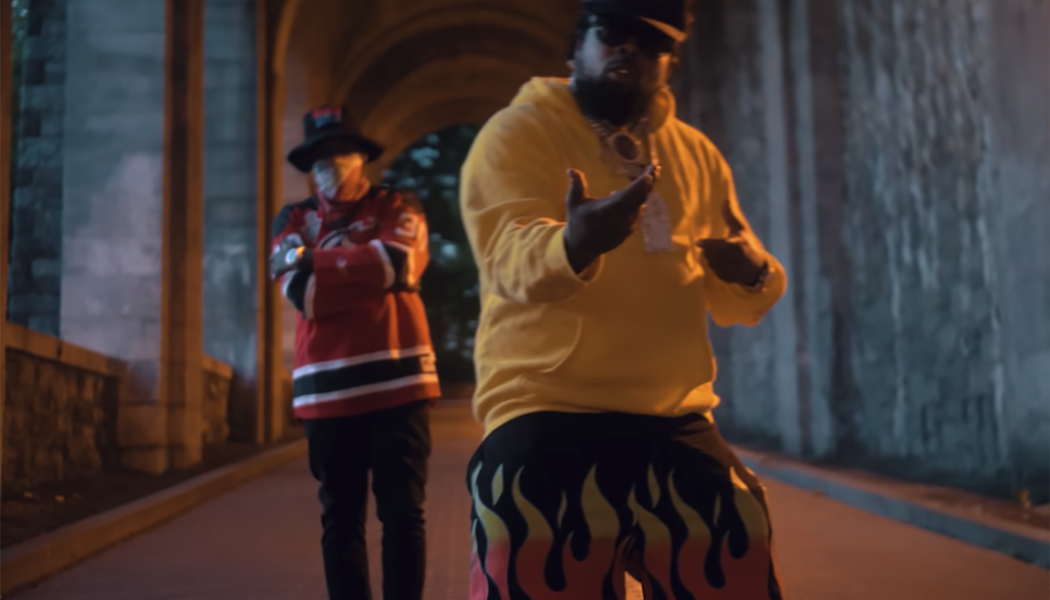
Pray For Haiti is the first collaboration between Westside Gunn and Mach-Hommy since they first went their separate ways in the early 2010s. Fans came up with all types of theories as to why there was friction, but at the end of the day, as Westside Gunn says, “We picked up right where we left off.”
Time apart couldn’t tarnish the impeccable synergy Mach-Hommy and Westside Gunn show on Pray For Haiti. Mach leads the way with his complex array of bars, while Gunn’s ability to curate a well-rounded tracklist brings the masked rapper’s vision to life. “Who the f–k I’m supposed to call?” says Mach when asked why Gunn was the best choice to executive produce his album. “There’s somebody else for me to call? He’s bringing the message in a form that they can receive, and he gets me. That’s rare.”
Flair didn’t need “The Brain” to have a successful run in the WWE, and the same can be said about Mach and his music. The “Stellar Ray Theory” rapper built a revered body of work without any real promotion or rollouts, and he made a name for himself with his mysterious yet intriguing persona.
Pray For Haiti is something of a coming-out party for Mach, who says he’s having a different type of fun this go around. Every album released up until Pray For Haiti was Mach having fun for himself, and now he’s ready to share that fun with fans. “I kept everybody in mind when I was having fun with Pray For Haiti,” Mach says. “What I’ve been doing for the past couple of years was be in my zone by myself, doing what I f–king like. But now I’m thinking in terms of us and we and stuff like that.”
Mach-Hommy is also making himself slightly more available to fans with this new chapter in his career. Interviews aren’t his thing, and there’s barely any information on him besides the music he’s put out. You won’t find Mach on social media either, but he realizes through Gunn the usefulness behind putting himself out there.
“I don’t like this press s–t, but that’s the whole point in having friends — because you get access through a different lens. And social media, I use it, but it’s just being used differently,” Mach admits to Billboard. “I can’t give all the game away, but I found a way to be there without having a burner account. Real talk, we need one social media per ten n—as, for real. We need to start carpooling to work and stop polluting the air.”
For Gunn, the reunion with his longtime friend is a chance for him to display what he calls “the top two ears for production of all time.” It’s a bold statement to make, but one that’s worth listening to, especially when that person was instrumental in resurrecting a dormant sound.
“Some people aren’t even confident to even let a Westside Gunn take the lead because they want to be the ones doing what I’m doing,” Gunn says confidently. “When you have someone that understands what I actually do, and they realize what they do, it’s undeniable. That’s why I really don’t like doing features, because I gotta rap on a beat that they picked. I do what I can, but I don’t do features — because other people don’t have the ear, they just have the money, and it’s never about the money. So my challenge was to give him the craziest beats I can hear him rap on.”
Westside Gunn is helping Mach achieve a monumental goal with Pray For Haiti, just like “The Brain” led Flair to a WWE championship. Pray For Haiti is not only an album, but a piece of Haitian culture that Mach is injecting into hip-hop. “I’m at the point in my life that I don’t need an excuse to do the inevitable,” Mach tells Billboard. “I was always headed towards this just off the way they nurtured and brought me up. I have the Pray For Haiti trust fund, and we’re putting money in that to give back to the country. Any country that’s having the type of difficulties Ayiti has had as a nation for so long, that’s real generational poverty and societal ills.”
Westside Gunn added, “I’m an honorary Haitian now. It feels good to do something for the country. Mach has the foundation that people can donate to and get things going. I want to support him for that. We’re bringing something beautiful to the culture while we’re doing something beautiful for the country. I’m happy to be involved. And I have to start talking Kreyòl lessons.”










